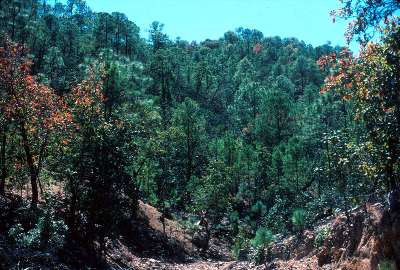Research in the Sierra Madre Occidental of Eastern Sonora, Mexico (Yécora region):
Introduction |
Foothills thornscrub (matorral espinoso) also occurs at 460 to 550 m elevation in the rain-shadow valley at Curea. Tropical deciduous forest (selva baja caducifolia) is found in a broad band at 500 to 1,160 m. Oak woodland (bosque de encino) is present at 1,050-1,700 m often in a mosaic with pine-oak forest (bosque de pino-encino) at 1,220 to 2,240 m. Mixed-conifer forest (bosque de coníferas-mixtas) with Durango fir (pinabete duranguense, Abies durangenis) at 1,900 to 2,100 m in deep canyons on the western and southwestern edges of Mesa del Campanero. Grassland (pastizal) occurs in high valleys at 1,200 to 1,700 m surrounded by oak woodland or pine-oak forest.
Acknowledgements
The web versions of the Yécora publications were compiled by Mark Dimmitt.
Many individuals have helped with research activities in the Yécora area. Padre Guillermo Trauba avidly collected plants with us for several years and provided lodging in the Hermanos Capuchinos missionary compound in Yécora. George Ferguson, Mark Fishbein, Mark Dimmitt, John Wiens, Doug Larson, Pinau Merlin, Mark Kaib, Eric Roalson, Victor Steinmann, Travis Columbus, Mark Porter, Richard Spellenberg, Tom Todsen, Alberto Búrquez, Francisco Molina, Reyna Castillo, Don Pinkava, Jon Rebman, Andrew Salywon, Tom Daniel, Mark Egger, Agustín Flores, Sam Friedman, José Luis León de la Luz , José Juan Pérez, Marielos Quintana, Maria Jesús Martínez, Rafaela Paredes, Carmen Ortega, Cristina Peñalba, Antonia López, Richard Felger, Michael Wilson, Paul Martin, and Raymond Turner also helped with plant collections.
We greatly appreciate the hospitality and willingness to share information of the families at El Kípor ( Luis and Lupe Coyote), Río Maycoba (Manuel Campa and Bertha), Rancho La Palmita (Don Ruben, Doña Ubelina, Sergio, and Oscar Coronado), Puerto de la Cruz ( Enrique Holguín), Rancho La Mula (Don Carlos and Doña Amada Meléndrez), Rancho La Palma Agujerada (Don Carlos and Doña Aurora Valenzuela), and Curea (Pedro Avilez, Doña Rosa, Pancho Encinas, Yaneth, and Luis).
Special thanks are due for the curators who deposited, and often identified, specimens into their herbaria: University of Arizona (ARIZ, Phil Jenkins, John and Charlotte Reeder), Universidad de Sonora (USON, Jesús Sánchez), Arizona State University (ASU, Don Pinkava), University of Texas at Austin (TEX, Billie Turner, Jim Henrickson, and Tom Wendt), New Mexico State University (NMC, Richard Spellenberg), California Academy of Sciences (CAS, Tom Daniel), Rocky Mountain Herbarium (RM, Ron Hartman), National Tropical Botanic Garden (PTBG, David Lorence), Missouri Botanical Garden (MO, George Yatskievych), Centro de Investigaciones Biológicas del Noroeste (HCIB, José Luis León de la Luz), Universidad Autónoma de México (MEXU [UNAM], Alfonso Delgado), Iztacala Campus-UNAM (IZTA, Oswaldo Tellez), and Universidad Autónoma Metropolitana (UAMIZ, Rosaura Grether).
Cristina Peñalba, Carmen Ortega, Antonia López, and Francisco Paz at UNAM-Hermosillo and USON collected and analyzed fossil pollen from the ciénegas at Camilo, El Kípor, and Cañada la Chimenea.
Karen Krebbs, Bill and Lorene Calder, Steve and Ruth Russell, Susan Wethington, Lee Rogers, Jeff Babson, and Joan Day Martin observed hummingbirds on various trips to the Yécora area.
Wayne Van Devender, George Ferguson, Cecil Scwalbe, Dick Bartlett, Mark Dimmitt, and Stephanie Meyer kindly allowed us to use their wonderful animal and plant photographs.
References
Búrquez M., A., A. Martínez Y., and P. S. Martin. 1992. From the high Sierra Madre to the coast: changes in vegetation along Highway 16, Maycoba-Hermosillo. Pp. 239-252 in K. F. Clark, J. Roldan Q., and R. H. Schmidt (eds.), Geology and mineral resources of the northern Sierra Madre Occidental, Mexico. Guidebook. El Paso Geological Survey Publ. 24, El Paso, TX.

